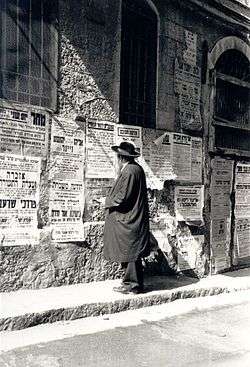Pashkevil


A pashkevil (Yiddish: פּאַשקעוויל; Hebrew: פשקוויל pl. pashkevilim פשקווילים) is a broadside or poster that has been situated on a public wall or location in an Orthodox Jewish community, and most commonly within Hareidi enclaves.[1][2] Pashkevilim are sometimes distributed anonymously; however, many are posted with rabbinic endorsements or the name of an activist group appended to the bottom.
Function
Per Samuel Heilman, the pashkevilim:
...make clear what is virtuous or acceptable behavior and what is not. They serve as expressive media that show what those who prepare and post as well as those who allow the poster to be displayed (the latter by attending to its meaning and not removing or covering it) consider to be acceptable or worthy of notice… The informed observer can thus use such signs as a window through which to glimpse what is appropriate behavior as well as what is on the mind of the community, its interests and concerns.[3]
Given the unique sociological insight to be garnered from their study, Israel's National Library has begun to acquire private collections of pashkevilim to be preserved in a special section available for academic research.[4]
Pashkevilim are additionally used to inform people when someone passes away.
Controversy
The authority of pashkevilim is subject to much dispute. The medium is frequently used as an anonymous means of publicly attacking or undermining a person or group (which is sometimes in violation of the Jewish laws of loshon hora), and even those that bear the names of leading Rabbis can be fraudulent.
Etymology
A column in the Jewish Daily Forward claims the word as a Yiddish term (pashkevil) borrowed from Polish paszkwil, which itself came from the French pasquil, from the Italian pasquinata (as does the English term "pasquinade" for a satire or lampoon).[5] The term has also been explained as a Yiddish word mean "protest or cry for help".[2] The word made its way "from Yiddish into the Hebrew of the Old Ashkenazi Yishuv in Jerusalem"[6] and was consequently adopted by Modern Hebrew.
See also
References
- ↑ Nurit Stadler (1 January 2009). Yeshiva Fundamentalism: Piety, Gender, and Resistance in the Ultra-Orthodox World. NYU Press. pp. 100–. ISBN 978-0-8147-4114-6.
- 1 2 Raz Yosef; Boaz Hagin (6 June 2013). Deeper than Oblivion: Trauma and Memory in Israeli Cinema. Bloomsbury Publishing. pp. 1–. ISBN 978-1-4411-9926-3.
- ↑ Samuel C. Heilman (2006). Sliding to the Right: The Contest for the Future of American Jewish Orthodoxy. University of California Press. pp. 212–. ISBN 978-0-520-24763-5.
- ↑ VIN News: Israel’s National Library Acquires Largest Known Collection of Israeli Pashkvillim
- ↑ On Language by Philologos: A Nude Who Inspired Modesty. Jewish Daily Forward, August 01, 2003.
- ↑ The Writing on the Wall by Rena Rossner. Jerusalem Post, 12/09/2005 01:27
External links
- Pashkevil Collection, National Library of Israel (in Hebrew)
| Wikimedia Commons has media related to Pashkavils. |